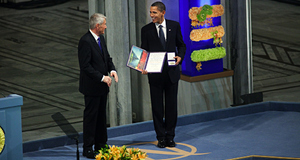The Obama PresidencyThe Myth of Obama's Post-Racial Presidency: Why Barack Obama's Election Didn't End Racial Inequality in AmericaEducate the MassesRacing to the TopIn his Blueprint for Change: Barack Obama’s Plan for America, the then-senator pledged that education reform would be one of his top priorities if elected to office. He pledged to reform No Child Left Behind (NCLB); support high-quality schools and close low-performing charter schools, make math and science education a national priority, address the dropout crisis, expand high-quality afterschool opportunities, support college credit initiatives, and support English language learners. 35 In July of 2009, President Obama and Secretary Duncan jointly announced the $4.35 billion overhaul of the federal education infrastructure to be known as the Race to the Top program (RTT). RTT’s focus lies in toughening state standards, improving the tracking of students’ performances, turning around failing schools, and improving the recruitment and retaining effective educators. 36 To achieve its set goals, RTT encouraged competition through its reward of block grants to public schools that achieved the most progress. Its precursors were competitive grant competitions between school districts funded by the Gates foundation. 37 As a product of compromise and political moderates, Race to the Top (RTT) is criticized throughout the political spectrum. Conservatives, who generally oppose the expansion of the federal government’s role in public education, object because of the additional federal involvement through RTT. Liberals and a large segment of the media opposed because of the program’s competitive nature. They believe that the money should be given to support state programs regardless of their achievement to provide each student with equal means. 38 Though both sides gave their arguments, neither addressed the biggest problem of RTT. Race to the top (RTT) is problematic because it doesn’t assist the urban non-white students at the very bottom in proportion to their need.Public education remains intertwined with housing patterns. Post World War II the metro areas of the states had large urban populations and huge patches of underdeveloped suburban land. ‘White flight’ prompted rapid development of suburban projects and the great migration of white families out of urban areas and into the suburbs. Policies such as zoning laws, legal housing segregation, and exclusion of blacks from federal mortgage lending programs, denied non-white families the same housing opportunities as white families. Since property taxes have been the largest source of funding for public schools, non-white students living in urban areas are disproportionately disadvantaged.39 Instead of addressing this prominent issue, RTT closely followed the No Child Left Behind (NCLB) educational policy with market-based reforms such as charter schools. The issue of expanding charter school programs and encouraging competition among school districts for block grants is that the students with the most need, the non-white youth in cities, are least likely to benefit from market-based incentives because of the lesser amount of resources they begin with.40 The privatization of public education exacerbates racial disparities and cause even more racial segregation in public schools. 41 In early 2014, the Obama administration launched the Race to the Top-Equity and Opportunity initiative. Data gathered by the Civil Rights Data Collection commissioned by the Department of Education, found racial disparities in school discipline, access to advanced courses and college counselors, among other concerns. The RTT-Equity and Opportunity initiative aims to address these disparities through a new $300 million competitive fund. The intent behind this program is directed at the problem, though the program itself will never resolve it through market-based solutions. Even with this directive, Obama has failed to effectively promote policy with equitable distribution in his administration’s education reform. Race in the Roberts CourtRacial attitudes have changed since the Civil Rights Movement in the 1960s. Americans have collectively progressed in their acceptance of racial differences. It is socially unacceptable or at least controversial to be visibly racist and use racial epithets. The U.S. has come a long way since public accommodations were legally separated with ‘for whites only’ and ‘for colored only’ signs. People of all racial backgrounds use water fountains and restaurants equally, and the younger generations only learn about the issues of that era from schoolbooks taught during Black History Month. Racial attitudes have slowly changed for the better, but they are not without flaws and have not created better understanding of the causes of lingering racial inequality. The racial privilege of the white population is still upheld by current institutions and policy. Existing racial disparities are residual of past discrimination. Thus, racial diversity in any area, including education, cannot be achieved through colorblind or race-neutral policy. The Supreme Court presided over by Chief Justice Roberts, fails to understand the continued need for policy that promotes racial diversity in education. A number of the Court’s decisions prior to and during the Obama administration reveals that the majority of justices believe our society has progressed passed racial distinctions and using race as means for diversity in schools discriminates against white students. Suits attacking race-conscious policies have been granted certiorari by the Court and ruled in their favor. Two of the most notable Court opinions in this regard come from the Parents Involved in Community Schools v. Seattle School District No. 1 (2006) and Fisher v. Texas (2013) cases. Seattle’s tiebreaker system in high school assignments was challenged in Parents Involved in Community Schools v. Seattle School District No. 1 (Parents). After the failure of the busing mandate, the Seattle school district sought to encourage voluntary racial integration by making each of its ten high schools attractive to students of all racial backgrounds.42 The program incentives of each school weren’t equally attractive, and as a result five of the schools were oversubscribed in the 2000-2001 school year. To combat the problem of not having enough spaces to accommodate all of the students’ first choices, the district employed four sets of tiebreakers to determine student assignments. The tiebreakers included sibling preference, geographic proximity, lottery assignments, and the school’s racial composition.43 A parent of a student that was denied admission to her top three school choices initiated the suit based on their claim that the student was discriminated against because of her race. The student was white and the decision to organize and sue the school district was based on the school board’s refusal to adopt recommendations that would downplay racial considerations. 44 The petitioners in Parents argued that the racial tiebreaker violated the Equal Protection Clause of the Fourteenth Amendment, the Civil Rights Act of 1964, and Washington state law. The federal District Court dismissed the suit and upheld the tiebreaker. The petitioners appealed the decision and the U.S. Court of Appeals for the Ninth Circuit reversed it. Later, the Ninth Circuit heard the case a second time en banc and held the school district had a compelling state interest to avoid racially concentrated schools. The Supreme Court granted certiorari to Parents in conjunction with a separate case, Meredith v. Jefferson County Board of Education, which had proceeded in the Sixth Circuit.45 After hearing oral arguments by both sides, the Court considered the following questions. Do the decisions in Grutter v. Bollinger and Gratz v. Bollinger apply to public high school students? Is racial diversity a compelling interest that can justify the use of race in selecting students for admission to public high schools? Does a school district that normally permits a student to attend the high school of her choice violate the Equal Protection Clause by denying the student admission to her chosen school because of her race in an effort to achieve a desired racial balance? 46 In a 5-4 decision, the Court applied a ‘strict scrutiny’ framework and found that the tiebreaker plan was unconstitutional under the Equal Protection Clause of the fourteenth amendment. 47 The decision to significantly limit the use of race in school admission during a time where racial isolation and housing segregation is increasing is troubling. Parents was decided three years before Obama entered office, however, analysis of the plurality opinion written by Chief Justice Roberts and the dissenting opinion of Justice Kennedy provides context of the Court’s decision in cases challenging higher education admission policies brought during the Obama administration. In the plurality opinion of Parents Chief Justice Roberts wrote, “[t]he way to stop discriminating on the basis of race is to stop discriminating on the basis of race.”48 Roberts and the justices who joined the opinion, reject voluntary adoption of race-conscious remedies in favor of policy that promotes colorblindness. With its decision, the Court has set a precedent that using race as a factor in admissions policy inherently discriminates. The belief that race no longer matters is proven false by the racial inequality in education. The Court rejected the argument that the Equal Protection Clause was intended to prevent the state from inflicting status harm against racial minorities. 49 This contradicts with the purpose of the Equal Protection Clause of the Fourteenth Amendment as it was written to specifically address the discriminatory aspects of the race-conscious Constitution that excluded slaves or people of African descent. The Fourteenth Amendment was created to extend the privileges of citizenship to blacks as a race-conscious remedy to slavery. 50 By ignoring the intent of the Fourteenth Amendment, the Court wrongly asserts that the Equal Protection Clause bans all distinctions based on race. In education enrollment policy, the Equal Protection Clause does not require that minorities and non-minorities be treated equally when trying to remedy distinct disadvantages. 51 Justice Kennedy dissented in parts III-B and IV Parents due to the language and analysis of Roberts’ opinion. He states: “parts of the opinion by the Chief Justice imply an all-too-yielding insistence that race cannot be a fact in instances when, in my view, it may be taken into account… and to the extent the plurality opinion suggests that Constitution mandates that state and local school authorities must accept the status quo of racial isolation in schools, it is in my view mistaken.” 52 Kennedy is correct in his stance that racial isolation should not be ignored. As history has shown, racial isolation and housing segregation leads to lowered quality of schools in districts predominantly occupied by racial minorities.53 In order to combat the issue of racial inequality in public schools, the school districts have to address the ‘compelling state interest’ of balancing race in school enrollments. Simply ignoring race will not make it irrelevant. Instead, it will lead to homogeneous student bodies void of diversity. Following the decision of Grutter v. Bollinger, the Supreme Court has ruled that ‘strict scrutiny’ be used to access the use of race by higher education institutions. The Court has stated that race is not the only means to a diverse student body, and as such the use of race will need to be confirmed as ‘necessary’ before it is approved. In a suit brought by a white Texan against the University of Texas at Austin (UT), the Court was once again presented with the issue of whether race in admissions or enrollment decisions violates the Equal Protection Clause of the Fourteenth Amendment. 54 Petitioner Abigail Fisher was denied undergraduate admission to UT in the fall of 2008. She filed suit in the U.S. District Court for the Western District of Texas alleging that the University’s use of race in its admission policy violated the Equal Protection clause and accepted minority students with less academic credentials than white students. UT argued that its holistic admissions process considered race as a factor and increased diversity within the student body that benefitted them all. Fisher disputed the UT’s policy as violating her Fourteenth Amendment rights. 55 Ultimately, the Court vacated the Fifth Circuit Court’s decision because it hadn’t used a strict scrutiny analysis, and remanded the case back to the lower court for further consideration. Fisher demonstrates the Roberts Court emphasis on race-neutral policy. Because race is no longer seen to inherently bring diversity, other considerations such as socioeconomic status and regional variance are argued to achieve diversity in student populations without the inclusion of race. While class and regional background are important factors to consider in admissions, when considered outside of race, they do not bring true diversity to higher education institutions. More than often, race-neutral policies, such as the ‘Top Ten Percent Plan’ in Texas, creates ‘tokens’ and don’t address the increasing issue of racial isolation. In Grutter v. Bollinger, the University of Michigan Law School argued that a critical mass of minority students was needed to diminish the force of stereotypes. The Law School argued that it had an interest “not to have large numbers of classes in which there are not students or only a single student of a given underrepresented race or ethnicity.”56 As was the case, at Michigan Law and in the UT schools, race-neutral policies failed to alleviate the large number of classes and programs with only token populations of minority students. 57 The Roberts Court’s decisions has further disadvantaged non-white students who have historically lower educational achievement than their white peers.Continued on Next Page » Suggested Reading from Inquiries Journal
Inquiries Journal provides undergraduate and graduate students around the world a platform for the wide dissemination of academic work over a range of core disciplines. Representing the work of students from hundreds of institutions around the globe, Inquiries Journal's large database of academic articles is completely free. Learn more | Blog | Submit Latest in Political Science |


















